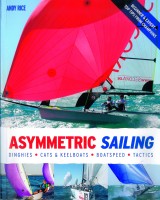From The Handbrake to The Hourglass, Matthew Sheahan discovers five easy ways to make a big difference downhill when sailing with an asymmetric
You’re blasting downhill on port with the big asymmetric set, searching for a fast route over the next set of waves. As you glance back over your right shoulder to look where the next gust is coming from you catch a glimpse of your ruler-straight wake flowing out behind. Flat out and on the edge of control, this is a golden ride, so long as you don’t have to make any big course alterations.
But in the back of your mind is the worry that you’ll have to give way to a starboard-gybe boat travelling at a similar pace. As your paths converge, you might find that heading up to climb over their transom is not possible in this amount of breeze without spinning out.
Even if you could maintain control, the chances are that you will accelerate and the angles will change, forcing you even higher. Get the angles and timing wrong and a high speed T-bone could be on the cards.
The alternative avoiding action isn’t so appealing either; a forced gybe will be tricky to pull off under pressure and could easily result in an expensive wipe-out.
Worse still is the stress of having to give way to boats beating up through the downwind fleet, all with rights over you and most of them obscured by the kite. A crash gybe here would not be pretty.
A forced gybe will be tricky to pull off under pressure and could easily result in an expensive wipe-out
You’re stuck between a rock and a hard place with your stress levels rising rapidly.
But there is a third, lesser-known option, a simple, safe and easy-to-employ technique that can not only take the stress out of the situation, but can be used as a tactical move in any wind strength: The Handbrake.
Thanks to some of the more ludicrously over-canvassed asymmetric sailing dinghies, this end of the sport has developed a number of techniques for handling their large downwind sail plans.
Yachting World contributor and accomplished skiff sailor Andy Rice has published a superb and thorough book on the subject of Asymmetric Sailing. Although biased towards dinghies and sportsboats, the book got us thinking about how the many hints and tips it contains might translate for the keelboat sailor. Here are five of the best.
1. The Handbrake
Oversheet the kite, heave it in as far as you can until you start to feel your speed bleed off as if you’re dragging a bucket. The angles between you and the boat you’re trying to avoid should start to change and in many cases you will only need to apply The Handbrake for a few seconds.
You don’t need to alter course and, contrary to what your instinct tells you, you’re unlikely to need to hike harder either.
Brilliantly simply and effective in all kinds of situations.
2. Trick hoists
When launching the kite – particularly from the companionway and assuming you have a non-overlapping headsail – use the windward sheet to barber haul the jib clew up towards the centreline, to allow a cleaner hoist to leeward.
During the hoist you will be sailing deep and the jib won’t be contributing much, if anything, to your speed.
3. Slick gybe set
Keeping the jib sheeted close to the centreline as for the Trick Hoist, almost backing it, can make a gybe set slicker. Because the kite is going up to windward, the breeze is trying to push the head back through the slot between the jib and the leeward side of the mainsail.
Backing the jib helps to close the slot and prevents the head of the kite from getting caught under the forestay at the hounds as it is being hoisted
4. The goosewing
The last time you did this might well have been in your early days of two-sail dinghies or after you had blown out your kite. But goosewinging an asymmetric kite for a few moments can gain you precious distance at key moments and is easy to do.
Simply square away to a dead run and flick the mainsail over.
A great trick when you’re fighting to get down to a leeward mark and/or are trying to sail deeper than a competitor.
5. The Hourglass
Whether after a ragged hoist or a slow gybe, the dreaded hourglass can wreck boat speed and any tactical strategy.
Seconds count and dithering can make the situation worse very quickly.
If the usual response – oversheeting and easing repeatedly – doesn’t work, try dumping the halyard a few metres and repeating the process. It’s tempting to head up to blow the twist out, but don’t; bear away instead.
Still no joy? Gybe, keeping as much sheet tension on as you can.
Asymmetric Sailing, by Andy Rice
Although aimed primarily at dinghies and small sportsboats, there is plenty for the keelboat sailor in this book.
Andy Rice is a championship-winning sailor in asymmetric classes and has sailed with such greats as John Merricks, Ian Walker and Simon Hiscocks.
Published by Fernhurst Books £14.99.





